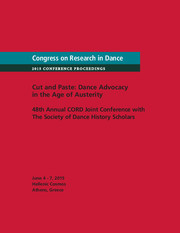No CrossRef data available.
Article contents
Immigration of Ideas, Or How Does a Camel Dance?
Published online by Cambridge University Press: 04 January 2013
Abstract
In this paper I intend to show how Israeli early dance was influenced by German Freitanz or Ausdruckstanz and how the intellectual and spiritual background of the period, both in Germany and in Palestine or Eretz-Israel, led to the wondrous establishment of Israeli dance, whether theatrical, social, or folk dance.
- Type
- Research Article
- Information
- Copyright
- Copyright © The Author(s) 2007
References
Notes
1. Toepfer, Karl, Nudity and Movement in German Body Culture, 1910–1913 (Berkeley: University of California Press, 1997), 12.Google Scholar
2. “To a defeated nation struggling to recover its competitive cultural identity, Jacques-Dalcroze's method appeared too Gallic in its reasonableness and … belief in the innate innocence of the body. The Germans now offered a body culture that showed less fear of the very shadows, the ‘dark’ inner pulses that Dalcroze tried so hard to pretend were merely mythical illusions” (ibid., 17).
3. Shapira, Anita, New Jews, Old Jews (Tel Aviv: Am Oved, 1997), 59.Google Scholar
4. A video projection shown during the presentation of this paper.


